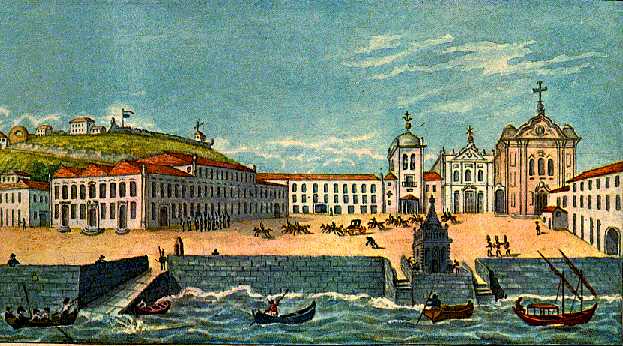MAIN MENU

| (The description of some places can be obtained by dragging the mouse over the picture) |
The Rio de Janeiro palace square in 1808, year of Portuguese Royal Family┤s
arrival in Brazil.
At right, the Royal Chapel (today Church of Our Lady of Carmel), for which JosÚ MaurÝcio was
nominated chapel master.
Watercolor by Richard Bates. Cornell University Library, USA.
| FOREWORD |
|---|
|
|
|
Five centuries ago Portugual and Spain began to
colonize and explore the New World, recently discovered.
To extract its natural resources, they employed two
successful strategies: to conquer and submit the natives,
either pacifically or through firearms, and to import slave
working hands from Africa.
In both cases, subjected people had by obligation to accept the conqueror's cultural values, among them Catholic Religion. Music was a resource used by the missionaries to get closer to the natives. It is not rare to find, in centenary churches from Peru or Mexico, polyphony scores written in the natives' own languages. Once converted, after some learning they took part in choirs and orchestras playing in religious ceremonies. The same destiny was reserved for slaves with some talent for singing. Some fine european composers worked for the Church in Latin America, like Tomás de Torrejon y Velasco in Peru (17th century), Ignácio de Jerusalem in Mexico (18th century), Domenico Zipoli and Roque Ceruti in Argentina (18th century), and André da Silva Gomes in Brazil (18th and 19th centuries). But as musical education made progress, some native composers appeared, regardless their race. Indians and mulatos (half-breed) were not rarely seen making scores and conducting music. In Brazil, the finest of all native composers was Father José Mauricio Nunes Garcia, mulato and grandson of slaves. His works are quite unknown even for brazilian music lovers, what does not make justice to the great composer he was. Our objective is to uncover some of his works through sound files, in MIDI format. Unlike recorded MP3 files, MIDI files are sequenced, note by note. The main advantage of this process is their reduced size, what makes their download and play faster. The bad news is that it's impossible to reproduce human voices into them. |
| Have fun. |
|
|

|
Life |

|
Works |

|
Discography |

|
References |

|
Mapa do Site |

|
Collaborator's List |